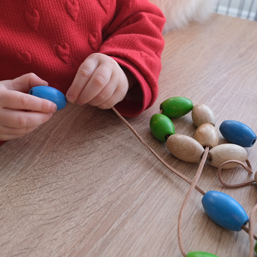
The fundamental skills your child learns in their early years help set them up for success with their future reading and writing. However, this doesn’t just include learning the alphabet and writing words. There is more to preparing your child for literacy success and it all starts with setting a solid foundation.
Here are three easy activities you can do at home to help your child reach their literacy potential:
1. Vocabulary enrichment. Vocabulary enrichment is the first step in literacy. During the first six years of life, children are in the sensitive period for language, which means they learn language almost effortlessly. Therefore, it is important to surround your child with language as much as possible. You can do this by singing to your child, using sign language, describing their surroundings, and reading to them every day. To continue to enrich your child’s vocabulary, there are many activities you can do with them at home, such as finger plays, poetry, and matching games.
One of my favorite vocabulary enrichment activities is a Recognizing Facial Expression Activity. All you need to set up this activity are a tray, cards, or photographs of children with different emotions/facial expressions and a small handheld mirror.
Once you have set up the activity:
This engaging and fun activity not only increases their vocabulary but also helps them understand and recognize non-verbal expressions.
2. Preparation of the hand. When it comes to writing, most people think about pencil skills but to ensure success in writing, you must first prepare the hand! Developing pincer grasp and strengthening your child’s hands and wrists are the best ways to promote proper writing skills. Everything your child grasps right from the beginning plays a role in preparing the hand. As they get older, it is essential to provide them with activities that help further refine their pincer grasp and fine-motor skills. Many different activities help your child prepare their hand for pencil skills, such as play dough, simple scissor cutting, tracing, and even LEGO.
One of my favorite activities that can grow with your child over the years is Bead Stringing. All you need to set up this activity are pipe cleaners and large beads on a tray.
Once you have set up the activity:
Bead stringing is consistently developing your child’s fine-motor skills, concentration skills, and hand-eye coordination.
3. Sounds before symbols. Montessori philosophy introduces phonetic sound before the letter name. Focusing on the phonetic aspect of letters allows a child to develop a concrete understanding of each letter and ensures less letter confusion.
When teaching phonetic letter sounds, the Montessori secret weapon is the Sandpaper Letters. These are exactly what they sound like, letters made of sandpaper. You can buy them as a set, or you can easily make them at home. What makes the Sandpaper Letters special? When using the Sandpaper Letters, your child is engaging multiple senses at once, which results in a deeper learning experience. All you need to do to set up this activity is cut the letters out of sandpaper and glue them onto a card (cardboard, cardstock, or light wood).
Once you have set up the activity:
When using the Sandpaper Letters, your child is not only hearing, seeing, and saying the letter sound, they are also tracing the letter, which allows muscle memory to come into play, creating an amazing multi-sensory experience that strengthens the learning process.
Setting a solid foundation is key to literacy success. When you provide your child with the tools that they need to develop the fundamental prerequisite skills for reading and writing, you are helping to ensure that they reach their full literacy potential.
Jenna is a mother, Montessori teacher, and owner of Evolve Montessori. Evolve Montessori is proud to be offering unique and exceptional Montessori programs for kids ages two to four. For more information, email This email address is being protected from spambots. You need JavaScript enabled to view it. or visit evolvemontessori.com. Feeling Social? Follow on Facebook and Instagram.
Calgary’s Child Magazine © 2024 Calgary’s Child